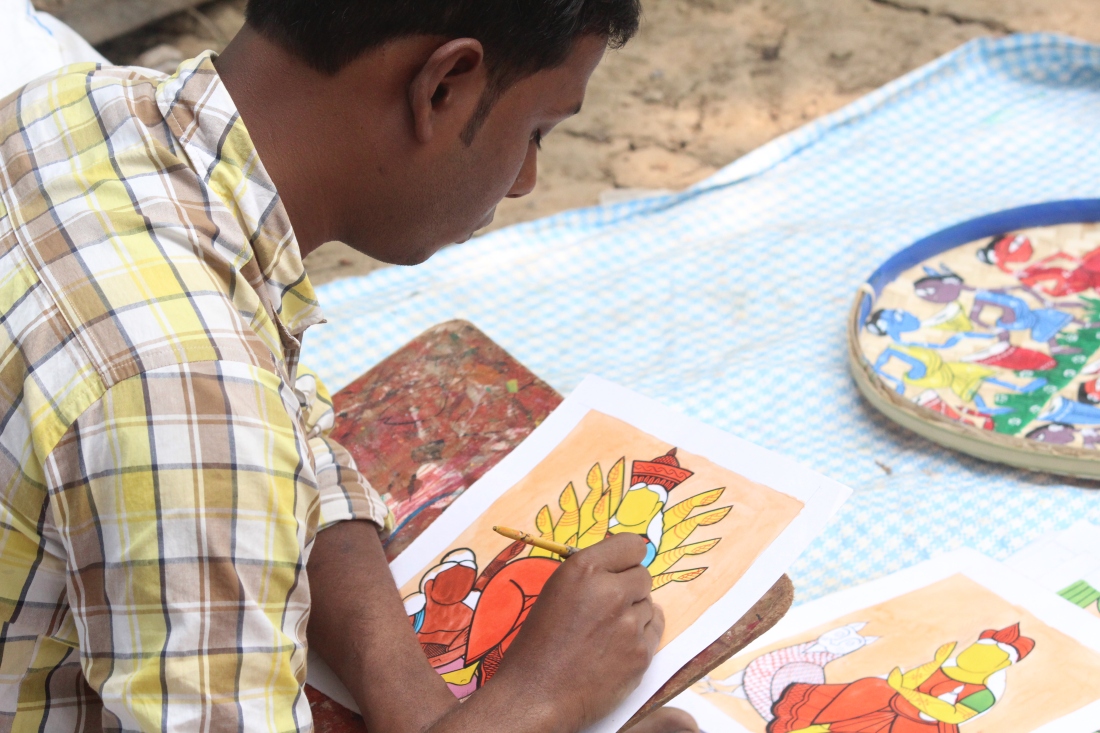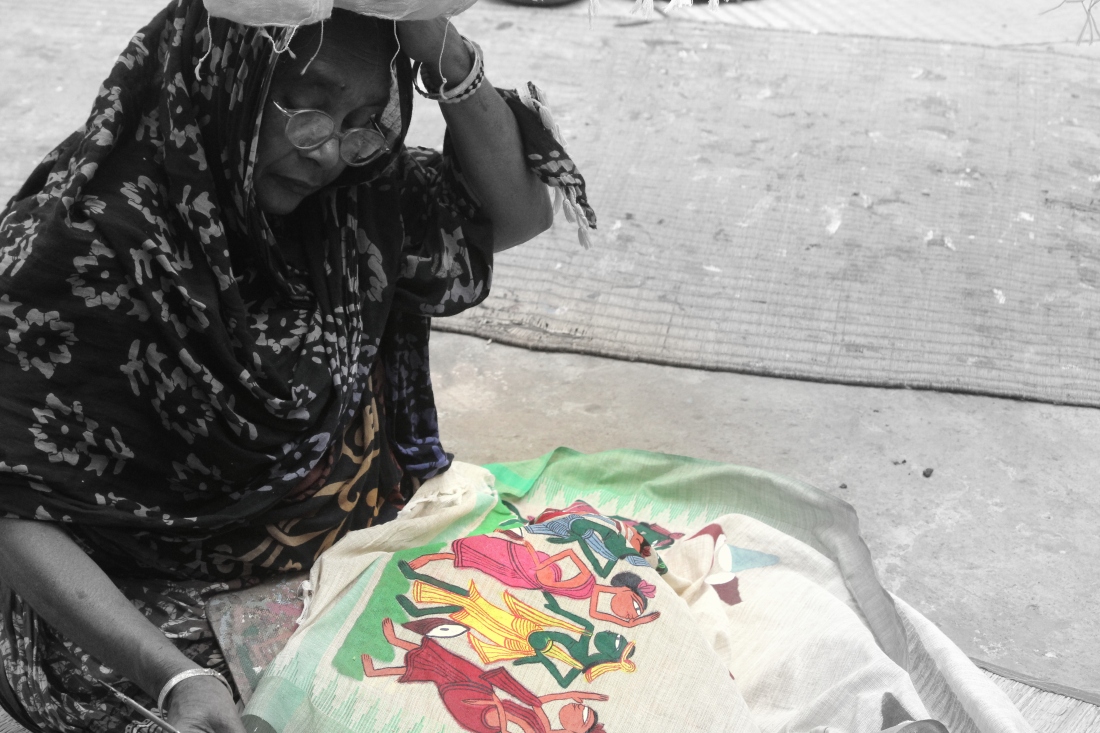The age-old myths and their manifestations do exist in this era of rationality and technical gluttony. Some months ago, I got a chance to walk on the soil where the painters of a forgotten genre are still fighting for their due recognition. They are the humble painters of the myths and folklores popularly narrated in the Hindu scriptures or by the clan of storytellers known as ‘Kathaks’.
Armed with the natural dyes, they are painting colourful stories told by the folks of the yesteryears. Their bold fingers are incessantly creating finer details on the canvas of their choice – a simple cloth bound “sheets of paper sewn together and sometimes stuck on canvas. Their widths can go from 4 to 14 inches and their length; often 3 feet can exceed 15 feet.” (https://www.deccanfootprints.com/collections/patua-scroll-paintings) are simply going on creating under the sun for the love of the art without knowing their goals. Well, that’s not true. They know their goal which is to earn a handful at the end of the day so that they can buy food to fill their stomachs and a bottle of local liquor to fill their hearts.
When I visited their village nested in a corner of West Medinipur district of West Bengal, India, a feeling of awe shrouded me all over. People do sketch and paint in their childhood, draw two triangular mountain peaks and a semi-circular rising sun or maybe a rose with a long stem and leaves, but who would have ever thought about revere an art form and make it a religion? I wouldn’t have known about this form of veneration if I didn’t make a visit there. The majority being Muslim by faith, they decided to shun the compartmentalization by taking up stories of hindu mythology and paint them accurately. They have also dropped their ancestral surnames and picked up the surname of ‘Chitrakar’ meaning painter in Bengali, their mother tongue.

They start their days with decorating the walls of their humble mud houses. When enquired, they put the brightest of their smiles and said that when there are left-over colours, we use them to paint on the walls. While strolling through the kuccha lanes and observing their exhibits, I looked above. The azure sky, green trees, red gravelly soil and the colourful paintings all seemed to be smiling in unison as they were victorious to incite a peaceful riot of colours.

The day melted away to evening. A black drape was put over on all their exhibits by the tip-toing night. We were called for dinner in Bahadur Chitrakar’s house. The house which we saw in the day time was no less than an established, famed art museum. Bahadur himself had painstakingly collected the souvenirs on display in his house by bartering away his own scroll paintings (known as Patachitra in Bengali) to those painters. His semi-permanent house proudly displayed the papyrus paintings, Egyptian artefacts, palm leaf scrolls known as “tala pattachitra” (http://gaatha.com/palm-leaf-pattachitra/) from the neighbouring painters of Odisha, mirror works from Rajasthan and many more such jewels lost in the sands of time.
The Government wants to buy his collections, repair his house and make a museum near the village to display those collections. This offer has put Bahadur in a fix. He cannot decide what to do. He asked our opinion saying that he was illiterate; he did not know what would be good for him. His intoxicated voice had such a pain that we could not share our opinion with him. Now, when I think about that day, I can still feel the pained voice. This was the pain of illiteracy, indecisiveness, poverty and the pain of the father who did not wanted to bid farewell to his married daughter but had to do so under social compulsion.
Another incident happened in Bahadur’s house after we had our dinner. I want to include that incident as a concluding note. After we were done with our dinner, the painter wanted to gift us a ‘patachitra’ each. He asked our names one by one and went on creating beautiful paintings with them. He was being verbally assisted by his daughter, so that he ensured that the spellings of our names went right. His daughter faltered while spelling out my name in Bengali. The brush which he held on so firmly even in his inebriated condition got twitched. He looked up and mildly rebuked his daughter by saying that he had done everything to educate her and she failed in this minor test. His daughter went visibly embarrassed. Not embarrassed for her father’s scolding in front of the outsiders but because of her failure. Her and her father’s defeated faces continued to haunt me for a long time.
How to go?
- If you go by a car, you need to drive on NH6, reach Debra and take a left turn towards Balichak Station. Continue to drive on the same road till Mundumari. From Mundumari crossing take left towards Tamluk and halt at the second petrol pump on the way, that’s where the Naya village starts.
- If you take a train to Midnapore from Howrah, get off at Balichak station and hire a cab till the village.
Where to Stay?
If you want to stay at the newly established Government building for the development of the artist village, you need to contact Manu Chitrakar (9732731776/8101169643) or Bahadur Chitrakar (9734536388) to book your stay. The resting spaces at the building is quaint yet comfortable. The per head per day expense of staying here with three meals is about Rs. 750/-.
Photography Courtesy: Avik Das.
For additional information, please follow the given link: http://snfictionality.blogspot.in/2016/12/blog-post_26.html









